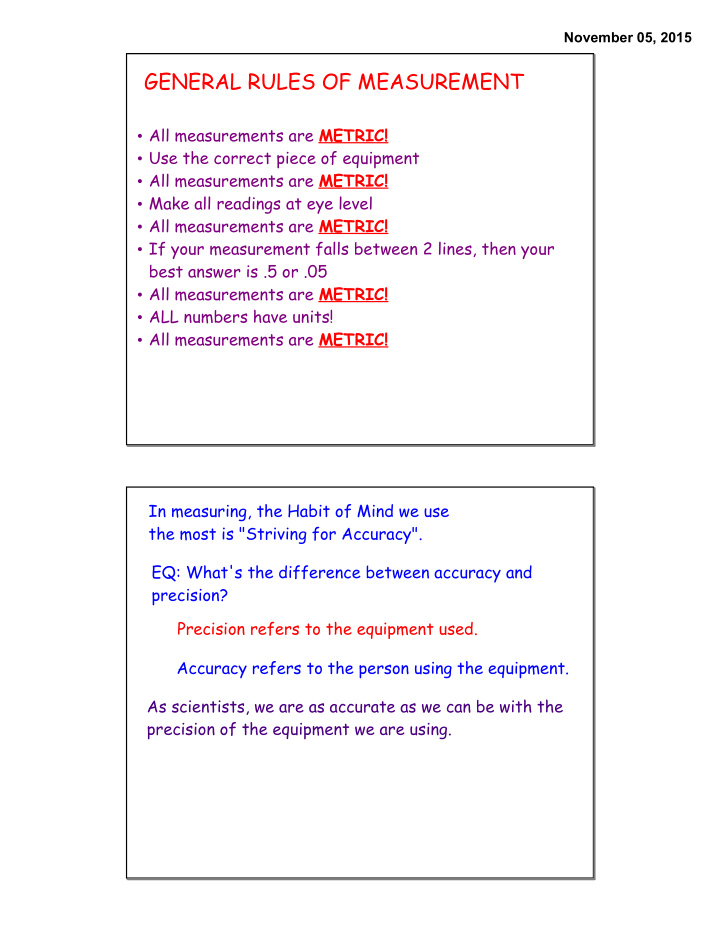



November 05, 2015 GENERAL RULES OF MEASUREMENT • All measurements are METRIC! • Use the correct piece of equipment • All measurements are METRIC! • Make all readings at eye level • All measurements are METRIC! • If your measurement falls between 2 lines, then your best answer is .5 or .05 • All measurements are METRIC! • ALL numbers have units! • All measurements are METRIC! In measuring, the Habit of Mind we use the most is "Striving for Accuracy". EQ: What's the difference between accuracy and precision? Precision refers to the equipment used. Accuracy refers to the person using the equipment. As scientists, we are as accurate as we can be with the precision of the equipment we are using.
November 05, 2015 Tools of a Scientist Measuring Basic Unit Equipment Length/Distance Meter Ruler/Meter Stick Graduated Cylinder/ Liquid Volume Liter Beaker Mass Gram Triple-Beam Balance Ruler Measuring Practice: Measure in cm then convert to mm and m Cube in cm in mm in meters Length Width Height Rectangle Block in cm in mm in meters Length Width Height Box in cm in mm in meters Length Width Height
November 05, 2015 Volume is the space an object occupies. To find the volume of a regular shaped object: · Measure length, width and height (don't forget the units) · Multiply these numbers: L x W x H (don't forget to multiply the units as well) EXAMPLE: 2 cm x 3 cm x 4 cm = 24 cm 3 Area is the top surface of an object. To find the surface area of the top of a regular shaped object: • Measure length and width (don't forget the units) • Multiply these numbers: L x W (don't forget the multiply the units as well) EXAMPLE: 2 cm x 4 cm = 8 cm 2
November 05, 2015 Rounding your FINAL answer: · Unless told differently, ALL answers should be rounded to 2 decimal places (nearest 1/100) · Even whole numbers will have numbers after the decimal point. · EXAMPLE: if your answer is 27 cm 3 , your final answer will be 27.00 cm 3 · Placing a "repeating bar" (27.66 cm 3 ) is NOT rounding. What should your correct answer be? Showing your work: Step 1: Write the formula (if it hasn't been given to you in the problem). Step 2: Fill in the formula with your measurements (DON'T FORGET UNITS!) Step 3: Solve the problem (DON'T FORGET UNITS and ROUNDING!)
November 05, 2015 Volume of the cube: _______cm X ______ cm X _______ cm =__________ cm 3 (length) (width) (height) Volume of the rectangle block: _______cm X ______ cm X _______ cm =__________ cm 3 (length) (width) (height) Volume of the box: _______cm X ______ cm X _______ cm =__________ cm 3 (length) (width) (height) Equipment: Graduated Cylinder Measures: Liquid Volume Basic unit: Liter Reading a Graduated Cylinder (GC): · Determine the scale -- different GCs have different scales so BE CAREFUL. · GC must be on a level, flat surface · Read at eye level · Read at the bottom of the meniscus http://www.cstephenmurray.com/onlinequizes/chemistry/measuring/readingthemeniscus.htm
November 05, 2015 What to do with a rock (or any other irregularly shaped objects)? What every good science student should know: • 2 forms of matter cannot exist in the same place at the same time. One will be pushed out of the way - in a GC the water will be pushed up • All measurements are are done in METRIC! • In the metric system, 1mL = 1cm 3 = 1 g • mL measures liquid volume and cm 3 measures solid volume So, we use the WATER DISPLACEMENT method. http://www.cstephenmurray.com/onlinequizes/chemistry/measuring/displacementmethod.htm Equipment: Triple Beam Balance Measures: MASS, which Basic unit: gram is the amount of matter in an object. Beams Indicator Adjustment knob 1 2 Pan Sliders/Riders
Recommend
More recommend